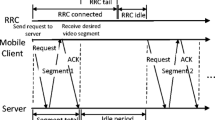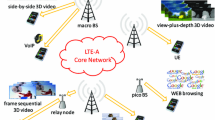Abstract
Video streaming, one of the most popular technologies for online video playback, has already been applied to 4G LTE networks. Previous work has been devoted to understanding the power consumption in general 4G LTE networks, while it is still unclear how the online video streaming makes impact on the power performance of mobile devices. Inspired by this, this paper investigates the relationship between the mobile device’s power performance characteristics and the behaviours of video streaming in 4G LTE networks. There are many natural issues/questions that are clearly interesting and important, while it is non-trivial to answer these issues/questions exactly (e.g., where is the energy saving room? how much is it?). To address a series of issues like the above, we formulate our energy models together with an algorithm that can assist our analysis. Particularly, we design a systematic platform, and conduct a comprehensive and also deep analysis on the power consumption of video streaming in 4G LTE networks. Our experiments reveal us a series of valuable findings—the saving room in the network part is large (from 41.86 to 69.62%), the number of RRC tails and the transmission pattern could be promising for optimizing the power consumption, for example.












Similar content being viewed by others
Notes
Simply speaking, the RRC tail refers to a network activity state that appears in some time interval. Its meaning will be clear after we introduce the background in Sect. 2.
Note that, reducing the number of RRC tails does not mean reducing the duration of a single RRC tail.
This model characterizes the “idle period with no traffic” in a more refined way.
Remark that these reference traces include themselves’ power traces and traffic traces. In our experiments the reference traces are obtained by “downloading video segment files”.
In this paper the hot point refers to a measured point whose power consumption is larger than some preset threshold. This threshold is asked to be larger than the power consumption of most measured points (that are extrated from the power trace of offline video playing).
Remark that the results in this table are obtained when we set the screen brightness to 100%. It is not hard to know that, if we set it to a lower value, the power consumption percentage of the network part shall increase. We emphasize that in this paper we are mainly interested in the power consumption of network part. The experimental results related to other parts could be mainly used for reference, whereas we believe those results are still useful, and thus we present them here.
A traffic point (resp., an idle point) refers to a measured point that has (resp., no) the data transmission.
In our experiments, \(\varDelta _{op}\) is conservatively set to 5%. In other words, if the potential saving room of a part or phase is less than 5%, we conceive conservatively it is not promising. In the following experiments, we shall not focus on studying such a part/phase.
Remark that it is the extreme case; this way, we can easily find out the extreme power saving room for online video streaming.
The reasons (the saving room varies) could be diversified (e.g., different configurations of network conditions).
Note that, we have attempted to observe directly the RRC states based on the process of video downloading. It, however, is not easy to observe the RRC phases (e.g., the RRC tail). In addition, the essence of video downloading is the transmission of packets. Here we thus simulate the process of the video downloading through sending the packets.
Note that, the QXDM tool can record eight local RRC states: Closing, IRAT To LTE Started, Suspend, Connected, Connecting, Idle Camped, Idle Not Camped, and Inactive. We can see that the local RRC states mentioned here is similar to, but somewhat different from the RRC states mentioned before. The RRC states mentioned before is a standard protocol. The local RRC states introduced by QXDM is used to differentiate the network activities in a more precise manner at the mobile client end.
This pattern involves five instant RRC states, while other three instant RRC states (i.e., IRAT To LTE Started, Suspend and Inactive) are not covered. This is mainly because our experiments are always conducted in 4G LTE networks, those three local RRC states naturally are not appeared in our traces. On the other hand, we can view the five local RRC states as following: the local “Connected” state corresponds to the RRC connected state; the local “Idle camped” state corresponds to the RRC idle state. The other three local states are the transitional states between the RRC connected and idle states.
The 4G LTE RRC states are different from those in 3G or previous mobile networks [14].
References
GSMA global mobile economy report 2015. http://gsmamobileeconomy.com/global/.
Ericsson mobility report: on the pulse of the networked society. (2015). http://www.ericsson.com/mobility-report.
Huang, T.-Y., Johari, R., McKeown, N., Trunnell, M., & Watson, M. (2015). A buffer-based approach to rate adaptation: Evidence from a large video streaming service. ACM SIGCOMM Computer Communication Review, 44(4), 187–198.
Stockhammer, T. (2011). Dynamic adaptive streaming over HTTP–: Standards and design principles. In MMSys (pp 133–144).
Zambelli, A. (2009). IIS smooth streaming technical overview. Microsoft Corporation, 3, 40.
Williams, M. (2016). Why are mobile phone batteries still so crap. http://www.techradar.com/news/phone-and-communications/mobile-phones/why-are-mobile-phone-batteries-still-so-crap--1162779.
Suneja, S., Navda, V., Ramjee, R., & de Lara, E. (2013). Envi: Energy efficient video player for mobiles. In CellNet (pp. 25–30).
Deruyck, M., Tanghe, E., Plets, D., Martens, L., & Joseph, W. (2015). Optimizing LTE wireless access networks towards power consumption and electromagnetic exposure of human beings. Computer Networks, 94, 29–40.
Eluwole, O. T., & Lohi M. (2012). Coordinated multipoint power consumption modeling for energy efficiency assessment in LTE/LTE-advanced cellular networks. In ICT (pp. 1–6).
Imran, R., Shukair, M., Zorba, N., & Verikoukis, C. (2015). An energy saving strategy for LTE-A multiantenna systems. Mobile Networks and Applications, 20(5), 692–700.
UMTS RRC protocol specification (version 12.4.0 Release 12). (2015).
Deng, S., & Balakrishnan, H. (2012). Traffic-aware techniques to reduce 3G/LTE wireless energy consumption. In CoNEXT (pp. 181–192).
Huang, J., Qian, F., Gerber, A., Mao, Z. M., Sen, S., & Spatscheck, O. (2012). A close examination of performance and power characteristics of 4G LTE networks. In MobiSys (pp. 225–238).
3GPP TR 25.813: Radio interface protocol aspects (V7.1.0). (2006).
Battery doctor: Get your phone lasting longer. http://www.cmcm.com/en-us/battery-doctor/.
Wang, H., Roman, E., Yuan, L., Huang, Y., & Wang, R. (2014). Connectivity, coverage and power consumption in large-scale wireless sensor networks. Computer Networks, 75, 212–225.
Vasilakos, V. (2016). A generic framework for energy evaluation on wireless sensor networks. Wireless Networks, 22(4), 1199–1220.
Li, P., Guo, S., & Jiankun, H. (2015). Energy-efficient cooperative communications for multimedia applications in multi-channel wireless networks. IEEE Transactions on Computers, 64(6), 1670–1679.
Xiang, L., Ge, X., Wang, C.-X., Li, F. Y., & Reichert, F. (2013). Energy efficiency evaluation of cellular networks based on spatial distributions of traffic load and power consumption. IEEE Transactions on Wireless Communications, 12(3), 961–973.
Lupia, A., & De Rango, F. (2015). Evaluation of the energy consumption introduced by a trust management scheme on mobile ad-hoc networks. Journal of Networks, 10(4), 240–251.
Tekkalmaz, M., & Korpeoglu, I. (2016). Distributed power-source-aware routing in wireless sensor networks. Wireless Networks, 22(4), 1381–1399.
Narendran, K., Karthik, R. M., & Krishna, M. (2016). Iterative power control based admission control for wireless networks. Wireless Networks, 22(2), 619–633.
Wang, K., Yu, J., Yu, Y., Qian, Y., Zeng, D., Guo, S., et al. (2016). A survey on energy Internet: Architecture, approach and emerging technologies. IEEE System Journal. doi:10.1109/JSYST.2016.2639820.
Jiang, H., Wang, K., Wang, Y., & Gao, M. (2016). Energy big data: A survey. IEEE Access, 4, 3844–3861.
Wang, K., Wang, Y., Sun, Y., Guo, S., & Jinsong, W. (2016). Green industrial Internet of Things architecture: An energy-efficient perspective. IEEE Communications Magazine, 54(12), 48–54.
Chen, X., Wu, J., Cai, Y., Zhang, H., & Chen, T. (2015). Energy-efficiency oriented traffic offloading in wireless networks: A brief survey and a learning approach for heterogeneous cellular networks. IEEE Journal on Selected Areas in Communications, 33(4), 627–640.
Pantazis, N. A., & Vergados, D. D. (2007). A survey on power control issues in wireless sensor networks. IEEE Communications Surveys and Tutorials (COMSUR), 9(1–4), 86–107.
Sharrab, Y. O., & Sarhan, N. J. (2013). Aggregate power consumption modeling of live video streaming systems. In MMSys (pp. 60–71).
Hsiu, P. C., & Pang, A. C. (2012). Energy-efficient video multicast in 4G wireless systems. IEEE Transactions on Mobile Computing, 11(10), 1508–1522.
Kao, C. C., Yang, S. R., & Chang, L. F. (2013). A resource allocation scheme for scalable video multicast in WiMAX relay networks. IEEE Transactions on Mobile Computing, 12(1), 90–104.
Go, Y., Kwon, O. C., & Song, H. (2015). An energy-efficient HTTP adaptive video streaming with networking cost constraint over heterogeneous wireless networks. IEEE Transations on Multimedia, 17(9), 1646–1657.
Ukhanova, A., Belyaev, E., Wang, L., & Forchhammer, S. (2012). Power consumption analysis of constant bit rate video transmission over 3G networks. Computer Communications, 35(14), 1695–1706.
Hu, W., & Cao, G. (2015). Energy-aware video streaming on smartphones. In INFOCOM (pp. 1185–1193).
Hoque, M. A., Siekkinen, M., & Nurminen, J. K. (2013). Using crowd-sourced viewing statistics to save energy in wireless video streaming. In MOBICOM (pp. 377–388).
Zhang, L., Pathak, P. H., Wu, M., Zhao, Y., & Mohapatra, P. (2015) Accelword: Energy efficient hotword detection through accelerometer. In MobiSys (pp. 301–315).
Holtkamp, H., Auer, G., Bazzi, S., & Haas, H. (2014). Minimizing base station power consumption. IEEE Journal on Selected Areas in Communications, 32(2), 297–306.
Tung, L.-P., Lin, Y.-D., Kuo, Y.-H., Lai, Y.-C., & Sivalingam, K. M. (2014). Reducing power consumption in LTE data scheduling with the constraints of channel condition and QoS. Computer Networks, 75, 149–159.
Zhang, J., Fang, G., Guo, M., & Peng, C. (2016). How video streaming consumes power in 4G LTE networks. In 17th IEEE International Symposium on a World of Wireless, Mobile and Multimedia Networks (WoWMoM) (pp. 1–3).
Aditya, S., & Katti, S. (2011). Flexcast: Graceful wireless video streaming. In MOBICOM (pp. 277–288).
Yin, X., Jindal, A., Sekar, V., & Sinopoli, B. (2015). A control-theoretic approach for dynamic adaptive video streaming over HTTP. In SIGCOMM (pp. 325–338).
Wang, K., Mi, J., Xu, C., Zhu, Q., Shu, L., & Deng, D. J. (2016). Real-time load reduction in multimedia big data for mobile Internet. ACM Transactions on Multimedia Computing Communications & Applications, 12(5s), 76:1–76:20.
Mukerjee, M. K., Naylor, D., Jiang, J., Han, D., Seshan, S., & Zhang, H. (2015). Practical, real-time centralized control for CDN-based live video delivery. In SIGCOMM (pp. 311–324).
Dobrian, F., Sekar, V., Awan, A., Stoica, I., Joseph, D., Ganjam, A., et al. (2011). Understanding the impact of video quality on user engagement. ACM SIGCOMM Computer Communication Review, 41(4), 362–373.
Balachandran, A., Sekar, V., Akella, A., Seshan, S., Stoica, I., & Zhang, H. (2013). Developing a predictive model of quality of experience for internet video. ACM SIGCOMM Computer Communication Review, 43(4), 339–350.
Acknowledgements
We would like to acknowledge the editors and anonymous reviewers for their precious comments. Also, we gratefully acknowledge the warm help of Prof. Sheng Wei, who offered us valuable advices. This work is supported in part by gifts from Adobe Research at Adobe Systems Incorporated; and supported by the National Basic Research (``973'') Program of China (2015CB352403), the National Natural Science Foundation of China (61261160502 and 61272099), the Scientific Innovation Act of STCSM (13511504200), and the EU FP7 CLIMBER project (PIRSES-GA-2012-318939).
Author information
Authors and Affiliations
Corresponding authors
Rights and permissions
About this article
Cite this article
Zhang, J., Wang, ZJ., Guo, S. et al. Power consumption analysis of video streaming in 4G LTE networks. Wireless Netw 24, 3083–3098 (2018). https://doi.org/10.1007/s11276-017-1519-9
Published:
Issue Date:
DOI: https://doi.org/10.1007/s11276-017-1519-9




